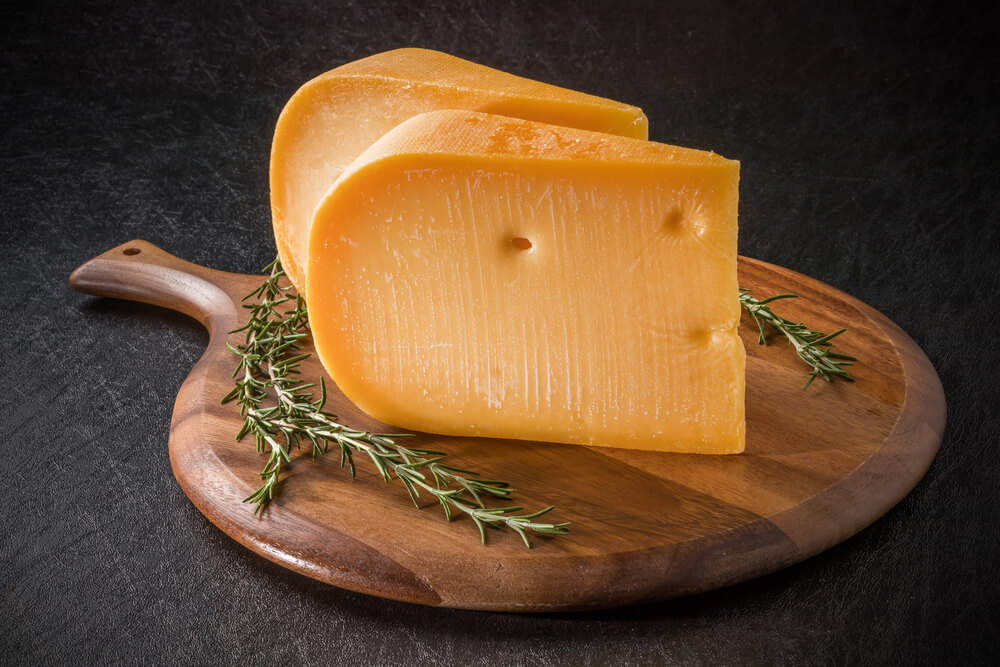What Is Gouda Cheese? Gouda is an ancient cheese with a colorful, wax-covered rind and flavor that ranges from slightly sweet and buttery when young to intensely nutty and caramelized when aged for a year or more.
It is widely available as an artisanal cheese suitable for cheese plates and as a young cheese that slices and melts well for sandwiches.
What Is Gouda Cheese?
Gouda is synonymous with the Netherlands, where this style of cheese dates back to the 1500s and possibly the 12th century. In fact, Gouda is named after the town of Gouda, which is home to one of the country’s bustling cheese markets.
Between the 1500s and 1700s, the Dutch became adept at cheesemaking, developing techniques for creating durable, long-lasting cheeses like Gouda and Edam. It was easily recognizable by its long-lasting, durable and colorful exterior, thanks to its low moisture content and saffron-vinegar-treated shells.
Unlike many iconic European cheeses, Gouda does not have a protected designation of origin (PDO). These regulations define criteria for the production of cheeses that can be sold under a particular label. As such, the quality of gouda varies widely, with both commercial cheeses and small-scale artisanal gins marketed under its name. A good rule of thumb is to look for Goudas, which are made in the Netherlands and tend to be of higher quality.
Boerenkaas is a Dutch word for “farm” cheese in the United States. In other words, it is cheese made from the milk of animals living on the farm where the cheese is made. However, the word Boerenkaas also goes a step further, requiring that all cheeses labeled as Boerenkaas are also made from raw (unpasteurized) milk. Only a small percentage of Dutch Gouda can be called Boerenkaas.
The rest of the Gouda made in the Netherlands comes from dairy cooperatives that collect milk from many farms to make cheese. A well-known Dutch cooperative is Beemster, which sells its Gouda in the United States.
All About Dutch Cheese Varieties
How to Make Gouda Cheese
Raw or pasteurized milk is heated, then cultures are added to start fermentation and acidify the milk. Then rennet is added to coagulate the milk into a gel-like clot.
Its two main properties are that it tastes sweet and has low moisture, and the next steps build these properties. The clots are scalded and mixed with hot water; These techniques expel moisture from the clots. The whey is then rinsed and most of the lactose in the cheese is taken with it. Because this lactose will not convert to lactic acid during the aging process, the result is a sweeter cheese.
The folds are then strapped into large circular molds and pressed to remove more moisture. The wheels are then soaked in brine before applying a thin coating of food-grade wax that gives the cheese its signature glossy, colorful exterior. The wheels are then placed in the cheese cave to age for anywhere from a few months to several years. High-quality, long-lasting wheels can develop crystals of tyrosine, an amino acid, or calcium lactate, which is a byproduct of the breakdown of lactose into lactic acid.
Some varieties of Gouda have a pale yellow or whitish color, while others have a deep golden or orange color. The orange color comes from adding annatto to milk before cheese is made, similar to cheeses like Cheddar and Colby. Annatto is the seed of the achiote plant and is used as a natural food coloring. When you see small holes in Gouda, it’s because cultures of lactic bacteria that produce CO2 are added to the milk. CO2 produces bubbles (gas) that create tiny holes or eyes in the cheese.
Varieties of Gouda
The main difference in Gouda’s styles is age. Young Gouda is typically softer, softer in flavor, springy to the touch, and lighter in color. A year old or more, Gouda has a deeper color, a firm, crystalline texture, and more concentrated flavors and aromas of toffee, brown butter, and toasted hazelnuts.
The longer the gouda ages, the denser the cheese becomes; Harder and denser in texture, with bold flavors that can be sharp, salty, sweet, nutty, and caramelized at the same time. The texture also changes, becoming hard, crumbly and really dense.
How to use?
Both young and old Gouda work well for certain applications. Young Gouda is ideal for slicing and melting in sandwiches, macaroni and cheese, casseroles, frittatas, quiches and other baked goods.
Older Gouda, on the other hand, does not melt well as it contains lower moisture. However, because its flavor is so much stronger, stale Gouda excels in other areas, such as grating it over pasta dishes like Parmesan or Pecorino. Both styles can be used as part of a cheese board.
How to store?
Store Gouda in its original packaging in the cheese drawer or crisper to protect it from the drying air of your refrigerator. After opening, re-wrap the remaining Gouda in cheese paper. Cheese can be stored in the refrigerator for two to three weeks.
If you don’t have cheese paper, wrap the cheese tightly in a piece of parchment paper and then place it in a plastic sandwich bag. Fold the bag around the cheese but do not seal it. This retains moisture while allowing air exchange.
Young Gouda can be wrapped tightly in plastic, sealed in a zip-top bag, and frozen for up to two months. Cheese can be thawed overnight in the refrigerator before use; however, its texture may be crumbly and unappetizing, so it is recommended for use in baked goods or other applications where cheese is to be melted. Old Gouda should not be frozen.
Can You Eat the Shell?
Young and old Gouda are covered with an inedible wax shell. It should be cut and discarded.
However, other varieties—like the smoked Gouda—have an edible, flavorful crust that you should definitely enjoy. It will be pretty obvious which one smoked Gouda’s crust is brownish, much thinner, and incredibly aromatic.





















































